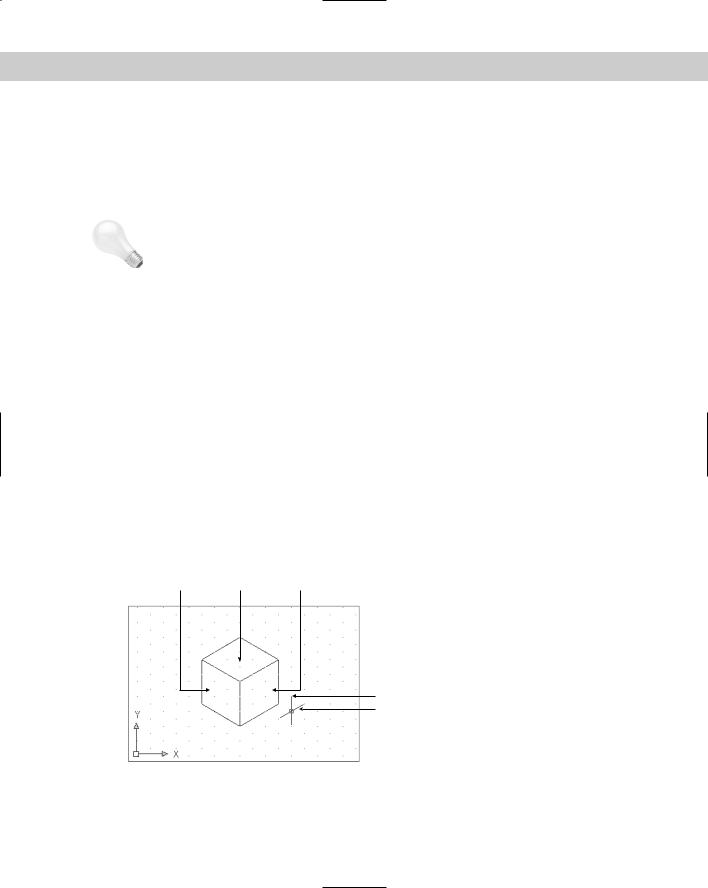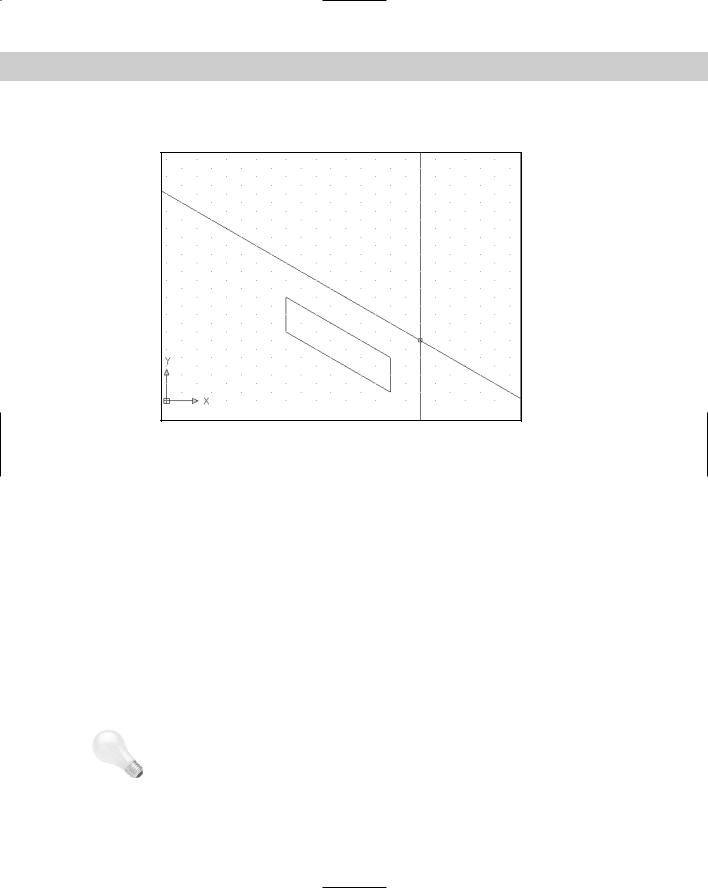
- •Foreword
- •Preface
- •Is This Book for You?
- •How This Book Is Organized
- •How to Use This Book
- •Doing the Exercises
- •Conventions Used in This Book
- •What the Icons Mean
- •About the CD-ROM
- •Other Information
- •Contacting the Author
- •Acknowledgments
- •Contents at a Glance
- •Contents
- •Getting Acquainted with AutoCAD and AutoCAD LT
- •Starting AutoCAD and AutoCAD LT
- •Creating a New Drawing
- •Using the AutoCAD and AutoCAD LT Interface
- •Creating Your First Drawing
- •Saving a Drawing
- •Summary
- •Creating a New Drawing from a Template
- •Working with Templates
- •Opening a Drawing with Default Settings
- •Opening an Existing Drawing
- •Using an Existing Drawing as a Prototype
- •Saving a Drawing Under a New Name
- •Summary
- •The Command Line
- •Command Techniques
- •Of Mice and Pucks
- •Getting Help
- •Summary
- •Typing Coordinates
- •Displaying Coordinates
- •Picking Coordinates on the Screen
- •Locating Points
- •Summary
- •Unit Types
- •Drawing Limits
- •Understanding Scales
- •Inserting a Title Block
- •Common Setup Options
- •The MVSETUP Command
- •Summary
- •Using the LINE Command
- •Drawing Rectangles
- •Drawing Polygons
- •Creating Construction Lines
- •Creating Rays
- •Summary
- •Drawing Circles
- •Drawing Arcs
- •Creating Ellipses and Elliptical Arcs
- •Making Donuts
- •Placing Points
- •Summary
- •Panning
- •The ZOOM Command
- •Aerial View
- •Named Views
- •Tiled Viewports
- •Snap Rotation
- •User Coordinate Systems
- •Isometric Drawing
- •Summary
- •Editing a Drawing
- •Selecting Objects
- •Summary
- •Copying and Moving Objects
- •Using Construction Commands
- •Creating a Revision Cloud
- •Hiding Objects with a Wipeout
- •Double-Clicking to Edit Objects
- •Grips
- •Editing with the Properties Palette
- •Selection Filters
- •Groups
- •Summary
- •Working with Layers
- •Changing Object Color, Linetype, and Lineweight
- •Working with Linetype Scales
- •Importing Layers and Linetypes from Other Drawings
- •Matching Properties
- •Summary
- •Drawing-Level Information
- •Object-Level Information
- •Measurement Commands
- •AutoCAD’s Calculator
- •Summary
- •Creating Single-Line Text
- •Understanding Text Styles
- •Creating Multiline Text
- •Creating Tables
- •Inserting Fields
- •Managing Text
- •Finding Text in Your Drawing
- •Checking Your Spelling
- •Summary
- •Working with Dimensions
- •Drawing Linear Dimensions
- •Drawing Aligned Dimensions
- •Creating Baseline and Continued Dimensions
- •Dimensioning Arcs and Circles
- •Dimensioning Angles
- •Creating Ordinate Dimensions
- •Drawing Leaders
- •Using Quick Dimension
- •Editing Dimensions
- •Summary
- •Understanding Dimension Styles
- •Defining a New Dimension Style
- •Changing Dimension Styles
- •Creating Geometric Tolerances
- •Summary
- •Creating and Editing Polylines
- •Drawing and Editing Splines
- •Creating Regions
- •Creating Boundaries
- •Creating Hatches
- •Creating and Editing Multilines
- •Creating Dlines
- •Using the SKETCH Command
- •Digitizing Drawings with the TABLET Command
- •Summary
- •Preparing a Drawing for Plotting or Printing
- •Creating a Layout in Paper Space
- •Working with Plot Styles
- •Plotting a Drawing
- •Summary
- •Combining Objects into Blocks
- •Inserting Blocks and Files into Drawings
- •Managing Blocks
- •Using Windows Features
- •Working with Attributes
- •Summary
- •Understanding External References
- •Editing an Xref within Your Drawing
- •Controlling Xref Display
- •Managing Xrefs
- •Summary
- •Preparing for Database Connectivity
- •Connecting to Your Database
- •Linking Data to Drawing Objects
- •Creating Labels
- •Querying with the Query Editor
- •Working with Query Files
- •Summary
- •Working with 3D Coordinates
- •Using Elevation and Thickness
- •Working with the User Coordinate System
- •Summary
- •Working with the Standard Viewpoints
- •Using DDVPOINT
- •Working with the Tripod and Compass
- •Getting a Quick Plan View
- •Shading Your Drawing
- •Using 3D Orbit
- •Using Tiled Viewports
- •Defining a Perspective View
- •Laying Out 3D Drawings
- •Summary
- •Drawing Surfaces with 3DFACE
- •Drawing Surfaces with PFACE
- •Creating Polygon Meshes with 3DMESH
- •Drawing Standard 3D Shapes
- •Drawing a Revolved Surface
- •Drawing an Extruded Surface
- •Drawing Ruled Surfaces
- •Drawing Edge Surfaces
- •Summary
- •Drawing Standard Shapes
- •Creating Extruded Solids
- •Drawing Revolved Solids
- •Creating Complex Solids
- •Sectioning and Slicing Solids
- •Using Editing Commands in 3D
- •Editing Solids
- •Listing Solid Properties
- •Summary
- •Understanding Rendering
- •Creating Lights
- •Creating Scenes
- •Working with Materials
- •Using Backgrounds
- •Doing the Final Render
- •Summary
- •Accessing Drawing Components with the DesignCenter
- •Accessing Drawing Content with Tool Palettes
- •Setting Standards for Drawings
- •Organizing Your Drawings
- •Working with Sheet Sets
- •Maintaining Security
- •Keeping Track of Referenced Files
- •Handling Errors and Crashes
- •Managing Drawings from Prior Releases
- •Summary
- •Importing and Exporting Other File Formats
- •Working with Raster Images
- •Pasting, Linking, and Embedding Objects
- •Summary
- •Sending Drawings
- •Opening Drawings from the Web
- •Creating Object Hyperlinks
- •Publishing Drawings
- •Summary
- •Working with Customizable Files
- •Creating Keyboard Shortcuts for Commands
- •Customizing Toolbars
- •Customizing Tool Palettes
- •Summary
- •Creating Macros with Script Files
- •Creating Slide Shows
- •Creating Slide Libraries
- •Summary
- •Creating Linetypes
- •Creating Hatch Patterns
- •Summary
- •Creating Shapes
- •Creating Fonts
- •Summary
- •Working with Menu Files
- •Customizing a Menu
- •Summary
- •Introducing Visual LISP
- •Getting Help in Visual LISP
- •Working with AutoLISP Expressions
- •Using AutoLISP on the Command Line
- •Creating AutoLISP Files
- •Summary
- •Creating Variables
- •Working with AutoCAD Commands
- •Working with Lists
- •Setting Conditions
- •Managing Drawing Objects
- •Getting Input from the User
- •Putting on the Finishing Touches
- •Summary
- •Understanding Local and Global Variables
- •Working with Visual LISP ActiveX Functions
- •Debugging Code
- •Summary
- •Starting to Work with VBA
- •Writing VBA Code
- •Getting User Input
- •Creating Dialog Boxes
- •Modifying Objects
- •Debugging and Trapping Errors
- •Moving to Advanced Programming
- •A Final Word
- •Installing AutoCAD and AutoCAD LT
- •Configuring AutoCAD
- •Starting AutoCAD Your Way
- •Configuring a Plotter
- •System Requirements
- •Using the CD with Microsoft Windows
- •What’s on the CD
- •Troubleshooting
- •Index

Chapter 8 Viewing Your Drawing 151
11.Still in the dialog box, choose World, click Set Current, and click OK to return to your drawing. The UCS icon and crosshairs return to their familiar angle.
12.To return to the Rotated 45 UCS, choose Tools Named UCS to open the UCS dialog box. Choose Rotated 45 and click Set Current. Click OK to restore the Rotated 45 UCS.
13.Save your drawing.
Tip |
After creating a new, rotated UCS such as the one in the previous exercise, type plan (to start |
|
the PLAN command) and use the Current UCS option to remove the rotation. Now you aren’t |
|
working at an angle in your UCS. To return to the World UCS, type plan again and choose the |
|
World option to return to your drawing’s previous state. |
Isometric Drawing
An isometric drawing is a 2D drawing drawn to look like a 3D drawing. Every child learns how to draw a box that looks three-dimensional. By drawing parallelograms instead of squares, the drawing gives the impression of being in three dimensions. AutoCAD and AutoCAD LT enable you to do the same thing.
Understanding isometric planes
The ISOPLANE (short for isometric plane) command rotates the crosshairs to the special angles required for isometric drawing. You then toggle the ISOPLANE setting from left to right to top to draw on each of the three “planes.” As you do so, the angles of the crosshairs, snap, and grid change to the appropriate angles.
These angles are 30 degrees for the X axis, 90 degrees for the Z axis, and 150 degrees for the Y axis. As you toggle among the planes, you see the crosshairs take on various configurations of these angles. Figure 8-24 shows the standard isometric cube. You can see three sides — left, right, and top. In the figure, the crosshairs are set to the right isometric plane.
Left plane Top plane Right plane
y axis x axis
Figure 8-24: The isometric cube.

152 Part II Drawing in Two Dimensions
|
Isometric drawing is not often used for precise drawing because specifying the exact points |
|
that you need can be difficult. Also, true 3D drawing has mostly supplanted isometric drawing. |
|
It is, however, used for piping work as well as for illustrations. |
Tip |
Use snap points and object snaps as much as possible in an isometric drawing. Also, set the |
|
cursor to 100 percent of the screen to better visualize the isometric planes. (Choose Tools |
|
Options and click the Display tab.) The grid is also a helpful aid. |
Drawing in isometric mode
To start isometric mode, choose Tools Drafting Settings to open the Drafting Settings dialog box. On the Snap and Grid tab, in the Snap Type & Style section, choose Grid Snap (if it is not already selected), and then Isometric Snap. While you’re there, turn on Snap and Grid if you want them on. Click OK. After you’re in isometric mode, press F5 to toggle from plane to plane.
Drawing lines in isometric mode is fairly straightforward if the lines are parallel to one of the isometric plane angles. Circles and arcs in isometric mode must be drawn as ellipses and elliptical arcs. When you’re in isometric mode, the ELLIPSE command has an Isocircle option.
STEP-BY-STEP: Drawing in Isometric Mode
1.Start a new drawing by using the acad.dwt template.
2.Save the drawing in your AutoCAD Bible folder as ab08-04.dwg.
3.Right-click the SNAP button on the status bar and choose Settings. On the Snap and Grid tab, in the Snap Type & Style section, choose Grid Snap (if it is not already selected), and then Isometric Snap.
4.In the Snap section, ensure the Snap Y spacing is set to 0.5 and click Snap On. In the Grid section, ensure the Grid Y spacing is set to 0.5 and click Grid On. Click OK to return to your drawing.
5.Choose Tools Options and click the Display tab. In the Crosshair Size text box, change the cursor size to 100. Click OK.
6.Press F5 until you see the <Isoplane Left> prompt.
7.Do a Zoom Window to zoom into the area covered by the grid.
8.Start the LINE command. Follow the prompts:
Specify first point: Use the coordinate display to choose 3.4641,2, which is a snap point. (It may take you a while to find the point.) Specify next point or [Undo]: Choose 6.4952,0.25. (Press F6 if necessary to get dynamic absolute coordinates.)
Specify next point or [Undo]: Choose 6.4952,1.25. Specify next point or [Close/Undo]: Choose 3.4641,3.
Specify next point or [Close/Undo]: Right-click and choose Close to close the left side of the model. All these points are snap points.

Chapter 8 Viewing Your Drawing 153
The results are shown in Figure 8-25.
Figure 8-25: The left side of the iron plate. The cursor has been changed to extend to 100 percent of the screen.
9.Press F5 twice until you see <Isoplane Right> on the command line.
10.Start the LINE command again. At the Specify first point: prompt, pick 6.4952,1.25.
Press F6 twice to get dynamic polar coordinates. At the Specify next point or [Undo]: prompt, pick when the coordinates show 2.0000<30. At the Specify next point or [Undo]: prompt, use the polar coordinate display to draw a line of 1.0000<270. At the Specify next point or [Close/Undo]: prompt, draw a line of 2.0000<210. End the LINE command.
11.Press F5 twice until you see <Isoplane Top> on the command line.
12.Start the LINE command. Start the line at 8.2272,2.25, which is a snap point. Draw a line of 3.500<150 and continue another line of 2.000<210. End the LINE command. This completes the box.
13.Choose Ellipse from the Draw toolbar. Right-click and choose Isocircle from the short-
cut menu. At the Specify center of isocircle: prompt, choose 5.1962,3. At the
Specify radius of isocircle or [Diameter]: prompt, type .5 to draw the ellipse. Your drawing should look like Figure 8-26.
14.Change the cursor size back to 5 (%). Save your drawing.
Tip |
Polar coordinate display is very helpful while drawing isometrically. The coordinates are easier |
|
to understand than the unusual absolute snap point coordinates created by ISOPLANE. |

154 Part II Drawing in Two Dimensions
Figure 8-26: The completed iron plate with a hole in it, drawn isometrically.
Summary
In this chapter, you read how to control the display of your drawing. You learned about:
The PAN and ZOOM commands, including real-time pan and zoom and the many ZOOM options
Using Aerial View to pan and zoom
Saving several views of your drawing so that you can retrieve them quickly
Creating tiled viewports for drawing and editing, as well as how to name and display useful viewport configurations
Rotating the snap and grid
Creating a User Coordinate System, including how to save a useful UCS and then set it as current at any time
Setting the snap style to isometric to create isometric drawings, which are 2D drawings that give the appearance of three dimensions
In the next chapter, you discover how to start editing your drawings.
|
|
|
